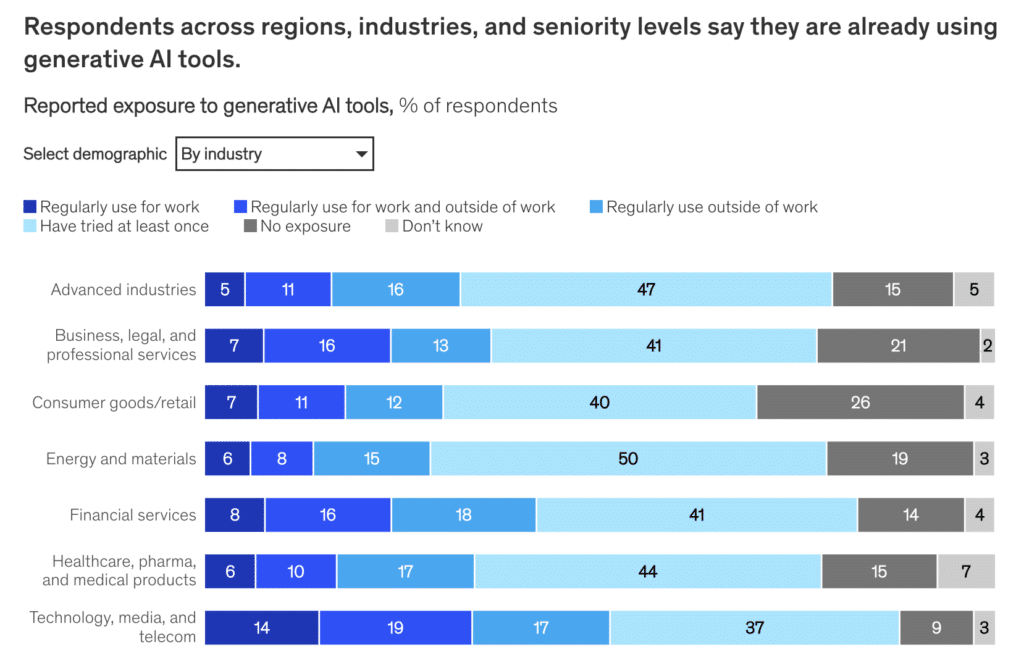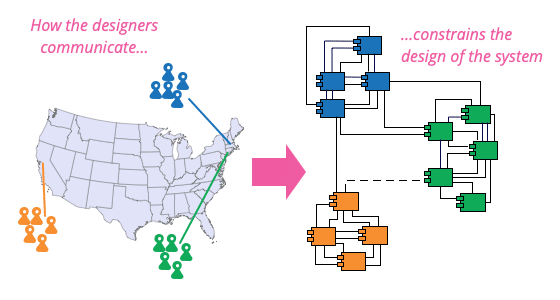The rapidly evolving AI landscape presents a multitude of opportunities for organizations. As AI’s capabilities expand, businesses are leveraging these advancements for cost reductions, revenue growth, market expansion, and product innovation (here are some real-world examples).
The McKinsey Global Survey on AI in 2023 highlights this evolution, revealing that despite the nascent stage of generative AI, its use is already widespread, with a third of respondents saying their organizations are utilizing generative AI in at least one function.

However, implementing AI in your organization is not a straightforward task. It requires a well-thought-out strategy. This guide provides a focused framework to set up a robust AI ecosystem and outlines the key considerations for an effective AI implementation strategy.
Creating a Robust AI Ecosystem: People, Process, and Technology
The difference between a successful AI implementation and a failed attempt often hinges on the strength of the foundational framework established at the outset. This is where the concept of creating a robust AI ecosystem using the People, Process, and Technology framework comes into play.
Think of it this way: People are your powerhouse, bringing creativity and expertise. Processes are the roadmap, guiding your team’s efforts in the right direction. And technology? That’s your toolbox. By blending these elements, we lay a solid foundation, ensuring your AI projects don’t just start strong, but also deliver real, lasting value.
People: Instituting a Chief AI Officer
In the domain of AI implementation, one of the most significant hurdles is the inherent resistance of traditional organizational structures and patterns (see Conway’s Law). In many cases, AI adoption within organizations mirrors existing departmental silos, legacy objectives, and entrenched power dynamics — which can lead to inefficient resource use, fragmented efforts, and misalignment with overall business goals.
A unified approach, transcending these boundaries, is key to harnessing AI effectively. Appointing a Chief AI Officer (CAIO) is a strategic move in this direction. This role is pivotal in steering the AI initiatives of an organization in a direction that aligns with its broader business strategies. What is your actionable step? Choose an expert, either from within or outside the organization, who understands both AI and your business’s unique needs.

Visual representation of Conway’s Law (source)
Process: Ensuring Data Readiness
The backbone of successful AI implementation is robust data management processes. AI models are only as good as the data they consume, making continuous data readiness crucial.
Here are the key processes that need to be in place to guarantee consistently high-quality data for AI models:
- Data Availability: Establish a process to regularly check on data availability. This isn’t just about quantity; it’s about the relevance and diversity of your data. For instance, if you’re using AI for customer service, is your system getting updated with the latest customer interactions and demographics? This continuous flow of varied data is vital for your AI to stay effective and adaptive.
- Data Quality Management: Imagine feeding your AI erroneous data. Not ideal, right? That’s where establishing data quality management processes comes in. This process ensures your data is accurate, complete, and consistently up-to-date — preventing any degradation that could mislead your AI, which can lead to erroneous outputs.
- Effective Data Governance: Lastly, let’s talk about governance. This is your rulebook for managing data. It involves setting clear roles, responsibilities, policies, and standards for how your data is handled and maintained. As your business and technology evolve, so should your data governance policies. This continuous adaptation ensures that your data management stays effective and compliant with current standards.
Technology: Robust Data Pipeline Platform
While much attention is given to the tools that build and run AI models, there’s another equally crucial component: the technology infrastructure that feeds these tools, the data pipeline platform. This is a key part of creating that robust AI ecosystem we mentioned earlier. The goal is to ensure your organization has the capability to process and prepare data effectively for your AI models.
Let’s dive into what this involves and how you can make it actionable in your own setting:
- Data Ingestion: First things first: getting the data into the system. Your data pipeline platform should excel in collecting data from a wide array of sources. This involves sophisticated methods to amalgamate data from disparate systems, databases, and formats into a unified format. Actionable tip? Start by mapping out all your data sources and ensure your data pipeline platform can integrate them seamlessly.
- Data Transformation: Once your data is in, it needs to be AI-ready. The platform should be equipped with powerful transformation capabilities, such as data enrichment, mapping, and filtering, to prepare data for AI model training and analysis. Why is this important? Well, raw data often isn’t in a state suitable for AI to process effectively. By transforming your data, you’re essentially tailoring it to fit the needs of your AI models.
- Scalability for Growing Data Needs: As data volumes and processing requirements increase, your data pipeline platform must be able to scale up without compromising performance. This scalability is vital to accommodate the evolving needs of AI models as they grow more complex and data-intensive.
- Automated Change Management: Change is a constant in the data world. Your platform should include automated change management capabilities to swiftly adapt to data changes, schema updates, and new integration requirements. This feature ensures that your data pipeline remains flexible and resilient, adjusting seamlessly to changes without manual intervention.
- Data Quality Checks: Instead of waiting until the end of the data pipeline to assess quality, choose a data pipeline platform that allows you to implement data quality checks at each stage. This approach allows for immediate identification and rectification of any data quality issues, preventing the need to reprocess the entire pipeline.
Key Considerations for Building an AI Implementation Strategy
Having explored the framework of People, Process, and Technology that forms the backbone of a robust AI ecosystem, we can now shift our focus to the key considerations of AI implementation. These considerations guide decision-making, ensure alignment with business goals, and prepare the organization for a smooth and impactful AI journey.
- Define Clear Business Objectives and AI Goals: Start by asking, “What specific problems are we aiming to solve with AI?” Your AI strategy should be tightly aligned with your business objectives. This alignment ensures that your AI initiatives drive tangible value, whether in improving customer experience, optimizing operations, or innovating products. Set measurable goals and key performance indicators (KPIs) to track the success of your AI projects.
- Assess Organizational Readiness and Capacity: Evaluate your organization’s readiness for AI adoption. This includes assessing the skills and knowledge of your team and the adequacy of your technological infrastructure. Do you have the necessary resources, or do you need to invest in upskilling your team or upgrading your systems? Understanding where you stand will help you identify gaps and plan accordingly.
- Develop a Comprehensive Data Strategy: Given that AI is heavily dependent on data, having a well-thought-out data strategy is crucial. This strategy should cover data collection, management, quality control, and governance. Ensure you have processes for continuous data readiness, as discussed earlier, to feed your AI models with high-quality, relevant data.
- Plan for Scalability and Future Growth: AI isn’t a one-time project but an evolving journey. Your AI strategy should not only address current needs but also be scalable to accommodate future growth and advancements in AI technology. This includes scalable data infrastructure, flexible AI models, and an adaptable team that can grow with your AI initiatives.
- Ensure Ethical AI and Compliance: Ethical considerations and compliance with relevant regulations must be at the forefront of your AI implementation strategy. This involves addressing biases in AI models, ensuring data privacy, and adhering to industry-specific regulations. Establish guidelines and ethical principles for AI use in your organization to foster trust and transparency.
The First Steps Towards AI Implementation
In a world abundant with information on AI, understanding its theoretical aspects is just the beginning. The real transformation occurs when we transition from merely grasping AI concepts to actively applying them within our organizations.
This article has highlighted the essential principles crucial for initiating your AI implementation journey. By approaching AI as a comprehensive project and methodically tackling the elements, the undertaking becomes far more approachable and structured. Remember, the journey to AI implementation is not just about adopting new technology; it’s harnessing the full potential of your data, leading to enhanced insights, improved operational efficiency, and smarter decision-making across your organization.




